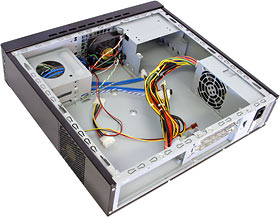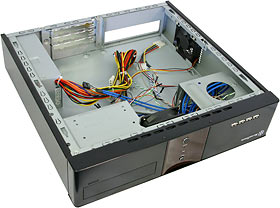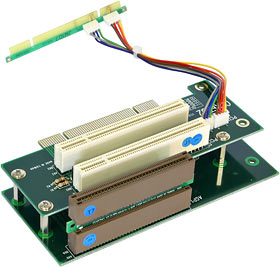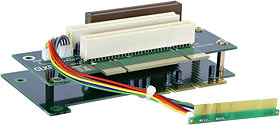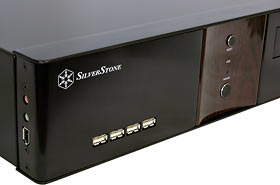
SilverStone LC11 HTPC case
Review date: 17 February 2005.Last modified 03-Dec-2011.
Home Theatre PCs (HTPCs) are an idea whose time has... almost come. The basic hardware has been there for years, now; video cards with decent quality TV output, TV tuner cards, large hard drives, DVD burners, consumer wireless networking; everything you need to get a box into your living room that'll let you record and play TV shows, but also play DVDs and MP3s and your favourite completely legally downloaded video files. There are DVD players that handle some computer video formats - the common flavours of DivX, for instance - but the plethora of audio and video codecs out there mean dedicated followers of digital entertainment fashion have to have a real computer on which to play stuff.
The problem has always been tying it all together so it's actually able to work, and then putting an interface on it that humans other than Dilbert can use.
The interface is... well, it's definitely getting there. You've got your Windows Media Center Edition, you've got your MythTV, you've got your Freevo, and so on and so forth, including stuff that comes bundled with brand name computers. All of this software can now be used on a pretty broad variety of hardware, that hardware is now quite affordable; it's starting to look almost straightforward.
Any old box will do for an HTPC, and many nerds are not at all concerned about putting the finest, cheapest beige minitower they can find in their lounge room. PSU exhaust fan too loud? Nothing a cardboard-box muffler won't fix. Sorted.
If you'd prefer something a bit less out-of-place, though, plenty of companies can oblige, usually with computer cases made to look more or less like hi-fi components.
Why bother with the rest, though, when you can have "the most advanced microATX HTPC case in the world"?
Well, according to SilverStone, anyway.
This wonder of the ages is the SilverStone LC11 (SilverStone seem mildly embarrassed that the manual says it's called the "Lascala").
It's 96mm high, 424mm wide and 430mm deep (3.8 by 16.7 by 16.9 inches), so it'll stack neatly enough with standard full-size hi-fi components, and it's got an aluminium front panel (for pretty) and a steel chassis (for cheap). Here in Australia, Aus PC Market sell both this black version (with genuine fake wood inlay in the middle of the front panel) and a silver one (regrettably not provided with genuine fake mother-of-pearl) for $AU264 each, including Sydney metropolitan shipping (shipping elsewhere in the country costs more).
$AU264 is actually a pretty decent price for an HTPC case that includes a PSU. Because these things don't sell in huge volumes, and because they have expensive fancy finishes and unusually shiny buttons and so on, they generally cost rather more than you'd expect. Particularly when you consider that they're usually, actually, just gussied-up low profile desktop cases.
The LC11's got some genuinely innovative features, though, which become apparent as soon as you take the bottom off.
Yes, the bottom - not the top. The LC11's removable panel is this one, on the underside; the motherboard mounts in it upside down. This design makes sense for something that's expected to be stacked up with other hi-fi components; it's common for this kind of gear to use convection cooling, with a grille in the bottom for the air to come in through. An HTPC case's front panel isn't very big and can't have an unsightly expanse of chicken wire on it, and if it sucks air in through its top then it'll interfere with anything you put on top of it that's trying to inhale through its base. Flipping the system over inside means the LC11 will help the ventilation of, say, a receiver above or below it, not hinder it.
HTPC cases are often stuck with piddly little 60mm ventilation fans, which typically shift about 60% of the air flow of a similarly noisy 80mm unit. That's OK for the kind of HTPC that's running an old Socket 370 processor, or some similarly low-heat chip, but it's not OK if you want a grunty CPU in there to handle media encoding.
The LC11 has 80mm fans throughout. One on the side, which is what draws air in through the bottom grille, one at the front sucking what air it can through the slots at the bottom of the front panel, and one exhaust fan at the back of the power supply. That PSU is a 240 watt unit; not much by regular PC standards, but enough to run as much CPU as any sane person will want in an HTPC.
Two screws retain the bottom panel. Inside, there's a quite standard MicroATX-sized motherboard mounting tray - it's just on the opposite side of the case from where you expect it to be. The grille in the bottom panel is big enough that it ought to cover the location of the CPU socket on pretty much any MicroATX board; there's not enough clearance for a huge CPU cooler, of course, but the proximity of the side 80mm fan ought to mean the stock cooler will work fine on pretty much any chip.
The LC11 has one 5.25 inch bay with a matching "stealth" plate on the front - as is normal for HTPC cases - but it's also got a quite luxurious three 3.5 inch mounting locations - two in a cage on one side, and one under the 5.25 inch spot. Geeks who want their HTPC to have epic amounts of storage usually network it to a server full of drives somewhere else, but three bays means you can get the thick end of 700 real formatted gigabytes of storage into an LC11 without even having to go beyond the currently-best-value 250Gb PATA drives. Shell out for "300Gb" drives and 820 real formatted gigabytes can be yours.
You may also have noticed the three expansion slot holes on the back of the LC11. Normally, an HTPC as slim as this wouldn't have any regular expansion slots; maybe some odd non-standard half-height thing that only a few special cards fit, but not proper ones like these. You're expected to get an all-in-one mobo and forget about cards.
You may be wondering what the heck kind of motherboard has its expansion cards parallel to its main circuit board, like this. Practically none, but that doesn't matter, because the LC11 package includes...
...this. It's a riser card that moves two PCI slots and one AGP slot up and around so they line up with the holes in the back of the case.
The two main edge connectors on the riser card plug into the AGP and first PCI slot on your motherboard. The odd eight-fingered edge connector on a wire plugs into the next PCI slot along. That's all you have to do.
Now you can have a decent video adapter (I wouldn't try something too fire-breathing, but lots of midrange cards have more than enough power for HTPC applications), and a PCI TV tuner card, and still have one slot free for other stuff. If you're determined to roll with the PCIe crowd then you're out of luck, of course, but right now there's really no performance justification for doing that (as I've discussed before); there are still tons of motherboard options in the ancient hewn-from-basalt PCI-and-AGP department.
Getting back to the front panel - the fake wood looks decent, the spun aluminium buttons are tasteful, and there are, of course, front and side ports. Two audio, one FireWire, four USB...
...all of which run from the same gaggle of multi-wire plugs and single-conductor connectors as do the similar ports on the TJ06 I reviewed the other day. How many of the ports you can use depends on what headers you have on your motherboard. Pretty much everyone will be able to run two USB ports, most will be able to run four, and fewer people will be able to hook up the FireWire and audio connectors.
Overall
The LC11's flipped-board design is clever, but not really revolutionary. The case's decent ventilation and bundled riser card, though, make it distinctly superior to every other low profile HTPC case I've seen. Well, provided you want expansion slots and a speedy CPU, that is; if not, then go ahead and build your HTPC with an integrated-video mobo and modestly powerful CPU, with my blessing.
If you want most of a "real" PC's power in a surprisingly slim and neat-looking casing, though, the LC11 looks like a definite winner.
Recommended.
Buy stuff!
Aus PC Market no longer stock the LC11, but you can find a variety of
newer Silverstone HTPC enclosures
here.
(if you're not in Australia or New Zealand, Aus
PC Market won't deliver to you. If you're in the USA, try a price search
at
DealTime!)


